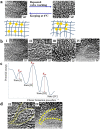Nanoparticle role on the repeatability of stimuli-responsive nanocomposites
- PMID: 25315841
- PMCID: PMC4197417
- DOI: 10.1038/srep06624
Nanoparticle role on the repeatability of stimuli-responsive nanocomposites
Abstract
Repeatability of the responsiveness with time is one important concern for effective durable functions of stimuli-responsive materials. Although the increase in the yield and tensile strength of the hybrid composite materials by nanoparticle (NP) incorporation has been reported, exact NP effect on stimuli-responsiveness is rarely reported. In this study, a set of nanoscale actuating system is demonstrated by a thermo-sensitive process operated by polyethylene glycol (PEG) linked by gold nanoparticle (AuNP). This designed nanocomposite exclusively provides an artificial on/off gate function for selective passages of permeate molecules. The results demonstrate high repetition efficiency with sharp responding in a timely manner. In terms of the morphology changes induced by repeated swelling-deswelling mechanics, the nanocomposite exhibits phase separation between AuNP clusters and PEG domains. This leads to a delay in responsiveness in a cumulative way with time. Acting as stable junction points in the nanocomposite network structures, the incorporated AuNPs contribute to maintain repeatability in responsiveness. This study contributes to new-concept smart material design and fundamental understanding on the hybrid nanomaterials for various applications in terms of a dynamic mechanical behavior.
Figures




Similar articles
-
Smart Actuators and Adhesives for Reconfigurable Matter.Acc Chem Res. 2017 Apr 18;50(4):691-702. doi: 10.1021/acs.accounts.6b00612. Epub 2017 Mar 6. Acc Chem Res. 2017. PMID: 28263544
-
Nanoparticle-Polymer Synergies in Nanocomposite Hydrogels: From Design to Application.Macromol Rapid Commun. 2018 Nov;39(21):e1800337. doi: 10.1002/marc.201800337. Epub 2018 Aug 17. Macromol Rapid Commun. 2018. PMID: 30118163 Review.
-
Multi-stimulus-responsive shape-memory polymer nanocomposite network cross-linked by cellulose nanocrystals.ACS Appl Mater Interfaces. 2015 Feb 25;7(7):4118-26. doi: 10.1021/am5081056. Epub 2015 Feb 16. ACS Appl Mater Interfaces. 2015. PMID: 25647407
-
Collagen/gold nanoparticle nanocomposites: A potential skin wound healing biomaterial.J Biomater Appl. 2016 Aug;31(2):283-301. doi: 10.1177/0885328216644536. Epub 2016 Apr 19. J Biomater Appl. 2016. PMID: 27095659
-
Stimuli-Responsive Drug Release from Smart Polymers.J Funct Biomater. 2019 Jul 31;10(3):34. doi: 10.3390/jfb10030034. J Funct Biomater. 2019. PMID: 31370252 Free PMC article. Review.
Cited by
-
Embedding topography enables fracture guidance in soft solids.Sci Rep. 2019 Sep 17;9(1):13493. doi: 10.1038/s41598-019-49986-1. Sci Rep. 2019. PMID: 31530891 Free PMC article.
-
Optimum periodicity of repeated contractile actions applied in mass transport.Sci Rep. 2015 Jan 27;5:7800. doi: 10.1038/srep07800. Sci Rep. 2015. PMID: 25622949 Free PMC article.
References
-
- Capadona J. R., Shanmuganathan K., Tyler D. J., Rowan S. J. & Weder C. Stimuli-responsive polymer nanocomposites inspired by the sea cucumber dermis. Science 7, 1370–1374 (2008). - PubMed
-
- Ahn S., Ahn S. W. & Song S. C. Thermothickening modification of the poly(ethylene glycol) and amino acid ester grafted polyphosphazenes by monomethyl end-capped poly(ethylene glycol) addition. Colloid Surf. A-Physicochem. Eng. Asp. 333, 82–90 (2009).
-
- Ahn S., Ahn S. W. & Song S. C. Thermosensitive amphiphilic polyphosphazenes and their interaction with ionic surfactants. Colloid Surf. A-Physicochem. Eng. Asp. 330, 184–192 (2008).
-
- Skorb E. V., Sviridov D. V., Möhwald H. & Shchukin D. G. Light responsive protective coatings. Chem. Commun. 40, 6041–6043 (2009). - PubMed
-
- Psarras G. C., Parthenios J. & Galiotis C. Adaptive composites incorporating shape memory alloy wires Part I Probing the internal stress and temperature distributions with a laser Raman sensor. J. Mater, Sci. 36, 535–546 (2001).
Publication types
LinkOut - more resources
Full Text Sources
Other Literature Sources
Miscellaneous

